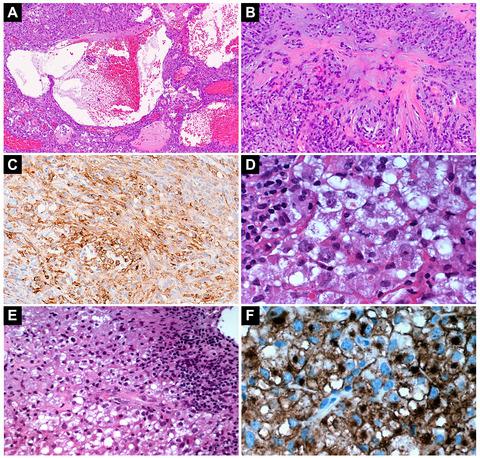当前位置:
X-MOL 学术
›
Brain Pathol.
›
论文详情
Our official English website, www.x-mol.net, welcomes your
feedback! (Note: you will need to create a separate account there.)
The spectrum of rare central nervous system (CNS) tumors with EWSR1‐non‐ETS fusions: experience from three pediatric institutions with review of the literature
Brain Pathology ( IF 5.8 ) Pub Date : 2020-09-30 , DOI: 10.1111/bpa.12900 Oscar Lopez-Nunez 1, 2 , Barbara Cafferata 3 , Mariarita Santi 4 , Sarangarajan Ranganathan 2, 5 , Thomas M Pearce 6 , Scott M Kulich 6 , Kelly M Bailey 7 , Alberto Broniscer 7 , Sabrina Rossi 8 , Angelica Zin 9 , MacLean P Nasrallah 3 , Marilyn M Li 3 , Yiming Zhong 3 , Evelina Miele 10 , Rita Alaggio 4, 8 , Lea F Surrey 3
Brain Pathology ( IF 5.8 ) Pub Date : 2020-09-30 , DOI: 10.1111/bpa.12900 Oscar Lopez-Nunez 1, 2 , Barbara Cafferata 3 , Mariarita Santi 4 , Sarangarajan Ranganathan 2, 5 , Thomas M Pearce 6 , Scott M Kulich 6 , Kelly M Bailey 7 , Alberto Broniscer 7 , Sabrina Rossi 8 , Angelica Zin 9 , MacLean P Nasrallah 3 , Marilyn M Li 3 , Yiming Zhong 3 , Evelina Miele 10 , Rita Alaggio 4, 8 , Lea F Surrey 3
Affiliation

|
The group of CNS mesenchymal (non‐meningothelial) and primary glial/neuronal tumors in association with EWSR1‐non‐ETS rearrangements comprises a growing spectrum of entities, mostly reported in isolation with incomplete molecular profiling. Archival files from three pediatric institutions were queried for unusual cases of pediatric (≤21 years) CNS EWSR1‐rearranged tumors confirmed by at least one molecular technique. Extra‐axial tumors and cases with a diagnosis of Ewing sarcoma (EWSR1‐ETS family fusions) were excluded. Additional studies, including anchored multiplex‐PCR with next‐generation sequencing and DNA methylation profiling, were performed as needed to determine fusion partner status and brain tumor methylation class, respectively. Five cases (median 17 years) were identified (M:F of 3:2). Location was parenchymal (n = 3) and undetermined (n = 2) with topographic distributions including posterior fossa (n = 1), frontal (n = 1), temporal (n = 1), parietal (n = 1) and occipital (n = 1) lobes. Final designation with fusion findings included desmoplastic small round cell tumor (EWSR1‐WT1; n = 1) and tumors of uncertain histogenesis (EWSR1‐CREM, n = 1; EWSR1‐CREB1, n = 1; EWSR1‐PLAGL1, n = 1; and EWSR1‐PATZ1, n = 1). Tumors showed a wide spectrum of morphology and biologic behavior. For EWSR1‐CREM, EWSR1‐PLAGL1 and EWSR1‐PATZ1 tumors, no significant methylation scores were reached in the known brain tumor classes. Available outcome (4/5) was reported as favorable (n = 2) and unfavorable (n = 2) with a median follow‐up of 30 months. In conclusion, we describe five primary EWSR1‐non‐ETS fused CNS tumors exhibiting morphologic and biologic heterogeneity and we highlight the clinical importance of determining specific fusion partners to improve diagnostic accuracy, treatment and monitoring. Larger prospective clinicopathological and molecular studies are needed to determine the prognostic implications of histotypes, anatomical location, fusion partners, breakpoints and methylation profiles in patients with these rare tumors.
中文翻译:

具有 EWSR1-non-ETS 融合的罕见中枢神经系统 (CNS) 肿瘤谱:来自三个儿科机构的经验以及文献回顾
与EWSR1-non- ETS 重排相关的 CNS 间充质(非脑膜上皮)和原发性神经胶质/神经元肿瘤组包括越来越多的实体,大多数单独报道,分子谱不完整。对来自三个儿科机构的档案文件进行了查询,以查找经至少一种分子技术证实的儿科(≤21 岁)CNS EWSR1重排肿瘤的异常病例。轴外肿瘤和诊断为尤文肉瘤 ( EWSR1) 的病例‐ETS 家族融合)被排除在外。其他研究,包括带有下一代测序和 DNA 甲基化分析的锚定多重 PCR,根据需要分别进行以确定融合伴侣状态和脑肿瘤甲基化类别。确定了五个病例(中位数 17 岁)(男:女为 3:2)。位置是实质 (n = 3) 和未确定 (n = 2),地形分布包括后颅窝 (n = 1)、额叶 (n = 1)、颞叶 (n = 1)、顶叶 (n = 1) 和枕叶 ( n = 1) 瓣。融合发现的最终名称包括促纤维增生性小圆细胞肿瘤(EWSR1-WT1;n=1)和组织发生不确定的肿瘤(EWSR1-CREM,n=1;EWSR1-CREB1,n=1;EWSR1-PLAGL1,n=1;和EWSR1-PATZ1,n = 1)。肿瘤表现出广泛的形态学和生物学行为。对于EWSR1-CREM、EWSR1-PLAGL1和EWSR1-PATZ1肿瘤,在已知的脑肿瘤类别中没有达到显着的甲基化分数。可用结果 (4/5) 报告为有利 (n = 2) 和不利 (n = 2),中位随访时间为 30 个月。总之,我们描述了五个主要EWSR1壬-ETS 融合的 CNS 肿瘤表现出形态学和生物学异质性,我们强调了确定特定融合伙伴以提高诊断准确性、治疗和监测的临床重要性。需要更大规模的前瞻性临床病理学和分子研究来确定这些罕见肿瘤患者的组织型、解剖位置、融合伙伴、断点和甲基化谱的预后意义。
更新日期:2020-09-30
中文翻译:

具有 EWSR1-non-ETS 融合的罕见中枢神经系统 (CNS) 肿瘤谱:来自三个儿科机构的经验以及文献回顾
与EWSR1-non- ETS 重排相关的 CNS 间充质(非脑膜上皮)和原发性神经胶质/神经元肿瘤组包括越来越多的实体,大多数单独报道,分子谱不完整。对来自三个儿科机构的档案文件进行了查询,以查找经至少一种分子技术证实的儿科(≤21 岁)CNS EWSR1重排肿瘤的异常病例。轴外肿瘤和诊断为尤文肉瘤 ( EWSR1) 的病例‐ETS 家族融合)被排除在外。其他研究,包括带有下一代测序和 DNA 甲基化分析的锚定多重 PCR,根据需要分别进行以确定融合伴侣状态和脑肿瘤甲基化类别。确定了五个病例(中位数 17 岁)(男:女为 3:2)。位置是实质 (n = 3) 和未确定 (n = 2),地形分布包括后颅窝 (n = 1)、额叶 (n = 1)、颞叶 (n = 1)、顶叶 (n = 1) 和枕叶 ( n = 1) 瓣。融合发现的最终名称包括促纤维增生性小圆细胞肿瘤(EWSR1-WT1;n=1)和组织发生不确定的肿瘤(EWSR1-CREM,n=1;EWSR1-CREB1,n=1;EWSR1-PLAGL1,n=1;和EWSR1-PATZ1,n = 1)。肿瘤表现出广泛的形态学和生物学行为。对于EWSR1-CREM、EWSR1-PLAGL1和EWSR1-PATZ1肿瘤,在已知的脑肿瘤类别中没有达到显着的甲基化分数。可用结果 (4/5) 报告为有利 (n = 2) 和不利 (n = 2),中位随访时间为 30 个月。总之,我们描述了五个主要EWSR1壬-ETS 融合的 CNS 肿瘤表现出形态学和生物学异质性,我们强调了确定特定融合伙伴以提高诊断准确性、治疗和监测的临床重要性。需要更大规模的前瞻性临床病理学和分子研究来确定这些罕见肿瘤患者的组织型、解剖位置、融合伙伴、断点和甲基化谱的预后意义。











































 京公网安备 11010802027423号
京公网安备 11010802027423号